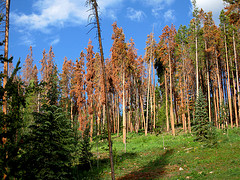Beetle-killed Forest: Why Harvesting May be the Best Option
By: Amos S. Eno
Posted on:12/22/2011 Updated:12/26/2011How Wood for Haiti proposes to improve western forests while aiding Haiti.
This is a continuation of our posts about the birth of Wood for Haiti, a new nonprofit that is seeking to rebuild Haiti and restore western forests at the same time.
Lodgepole, along with ponderosa pine, is the tree of choice for the mountain pine beetle. The mountain pine beetle is a native species that periodically infests large forest acreages when the right combination of weather and forest conditions (often related to an absence of active forest management) combine to promote a surge in the beetle population.
“In Montana, where more than 20% of o ur 21 million acres of timber have been infested by the beetle, there are very few plantation type timber stands. It’s not practical here. People generally go for multispecies plantings if they replant at all since local species tend to repopulate quickly,” says Roger Ziesak, a Forester with Montana Dept. of Natural Resources and Conservation who oversees forest practices programs on private lands. “There are only about five or six commercially viable species that grow in Montana, and lodgepole pine, one of the major commercial species and the preferred host for the mountain pine beetle, regenerates very well on its own.”
ur 21 million acres of timber have been infested by the beetle, there are very few plantation type timber stands. It’s not practical here. People generally go for multispecies plantings if they replant at all since local species tend to repopulate quickly,” says Roger Ziesak, a Forester with Montana Dept. of Natural Resources and Conservation who oversees forest practices programs on private lands. “There are only about five or six commercially viable species that grow in Montana, and lodgepole pine, one of the major commercial species and the preferred host for the mountain pine beetle, regenerates very well on its own.”
“We view harvesting of beetle-killed wood as beneficial,” continues Ziesak. “One reason is that lodgepole is a relatively short-lived species - about 100 years - and when the forest floor receives sunshine, there are plenty of lodgepole seeds that will sprout immediately. In addition, in stands of dead lodgepole, the trees rot and fall over after 5 to 7 years, creating a jack-strawed mess of fallen trees that creates a significant fire hazard as well as something that is extremely difficult for man or beast to walk through.” The state of Montana leaves 5 to 15 tons of woody debris on the ground when harvesting, which they deem sufficient for supplying nutrients for regeneration. These jack-strawed stands may have 100 tons or more per acre of downed material.
Damage in British Columbia makes Montana's Look Small
“The beetle killed acreage in British Columbia makes ours in Montana look small: they have around 45 million affected acres,” said Ziesak. “The Canadians are finding that when trees enter the ‘gray stage’ - having dropped all of their dead needles – the wildfire hazard is still very significant, with fires growing larger and burning hotter. The higher temperature fire can not only stop regeneration in its tracks but sometimes results in soil sterilization. This means all soil organisms and the seedstock in the soil is killed, and it can take 20 years or longer before any significant regeneration begins.”
Wood for Haiti is interested in harvesting beetle killed wood from any source: private or public lands. However, because landowners prefer the aesthetic of green trees or fear the fire hazard of all that dead wood, they have been harvesting at a high rate. The substantial majority of remaining standing dead timber is on public land, particularly on national forests.
“Here in Montana, there are about five million acres of beetle-killed timber that could be available for utilization. Much of it is on public land, and it presents a tremendous opportunity for an initiative such as Wood for Haiti, provided we can get the trees to the mill,” said Ziesak.
A Proactive Response to a Perfect Storm
The current outbreak of mountain pine beetle in Montana is the result of a “perfect storm” of factors: mild winters have allowed beetle numbers to skyrocket; the central part of Montana north and south of Helena, with about 80% of the damaged acres, has a high percentage of trees of the right size; and in some forests, lack of management has led to overcrowding, which stresses individual trees.
Wood for Haiti has a plan to help the region sail through this “storm” stronger than ever. The question is, will the plan be put into action?
Please read the conclusion of the inspiring Wood for Haiti story.
 Sign In
Sign In
 Sign In
Sign In
